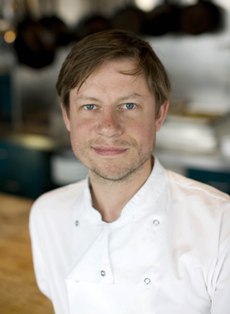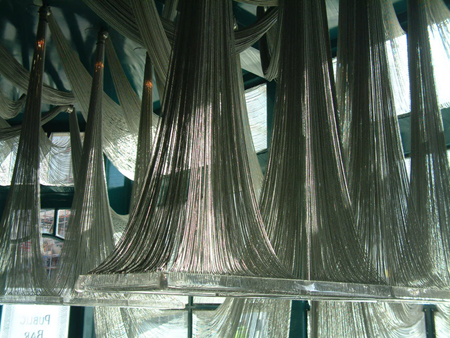Sustainable London and Beyond
Hits: 3573London is capable of providing fresh local food fit for one inner-city restaurant, so which integrated food and waste management strategies bring forth the radical agendas needed to create sustainable futures for all?
Fresh food from inside the M25
 Oliver Rowe, a young London chef, has set himself the task of attempting to source all his ingredients from within the M25, or from places accessible on the London Underground system.
Oliver Rowe, a young London chef, has set himself the task of attempting to source all his ingredients from within the M25, or from places accessible on the London Underground system.
His new 70-seater restaurant Konstam at the Prince Albert in Kings Cross, an area better known for salacious rather than salubrious activities, offers a menu of fresh and tasty locally produced food. So far, he has found lamb, pigeon and pork produced in Amersham, goat’s cheese churned in Chesham, honey from beehives atop Tower Hill tower blocks and flour milled at Ponders End.
Rowe's mission to cook local food is not solely motivated by the politics of foodmiles (the distance that food travels from farm to plate, see http://www.i-sis.org.uk/FMAS.php. It’s also a question of taste, and freshness. He said, “We are constantly being told to eat local food and I wanted to see if this was realistic in London.”
City farm provides staples
Staples such as eggs and milk are sourced simply from Spitalfields City Farm in London’s East End. However, ingredients such as oil and salt were harder to track down. A margin of cheating is allowed to supply salt from the mud flats of Essex and cold pressed rapeseed oil from Suffolk.
Fresh fish proved particularly challenging for the intrepid chef, who was laughed out of London’s Billingsgate fish market when he asked for locally caught fish. In fact, most of the fish sold at Billingsgate do not come from the UK at all. The quantity is insufficient to satisfy demand. A trout caught by Rowe in the lake at Hounslow is fine for an experimental dish, but bass, crab and Dover sole from the Thames Estuary are eaten at Konstam.
A wide range of seasonal vegetables and salads come from Rowe’s allotment in Barnet, North London. Nothing is wasted, not even the wild growing nettles that garnish the delicious goats cheese pierogi (dumplings) in crispy breadcrumbs. Rowe presides over his kitchen from what was the bar in the former pub. His warm and open smile greets each customer as they walk in.

image source Sam Burcher 2006
Supplies must meet local food demands
The striking silver beaded chandeliers that spiderweb across Konstam’s high ceiling, walls and windows may look like a set from Harry Potter. But the reality of Rowe’s practical actions demonstrate why strategies to localise food supply chains for London are needed. And he’s not alone. A renaissance of traditional recipes that rely on local foods to fulfil them is sweeping the country (see box). So far, it’s a trend that is driven by consumer demand, rather than the political will to change the ways that food is produced and distributed.
Local spending also affects local wealth. Every £10 spent with local food business is worth £20 compared to the £14 return when non-local food businesses. Currently 34 percent of food is eaten out in restaurants in the UK and is estimated to increase to 50 percent by 2025 so all aspect of food production and waste must be sustainable.
London’s strategies for localised food
A quarter of all London’s enterprises are food related. According to a recent research report by Sustain (The alliance for better food and farming) commissioned by The London Development Agency (LDA), food accounts for 41 percent of London’s total demands on natural capital and is a critical factor in the fulfilment of wider sustainable development objectives.
The London Sustainable Food Hub, opportunities for a sustainable food logistics centre in London examines the logistics of bringing sustainable food supplies to the city and outlines an alternative infrastructure for a centre that would supply the public sector and retailers with locally produced food. It put forward figures for required changes in food consumption as:
- 92 percent of food locally sourced
- 30 percent more vegetables and more cheese
- 20 percent reduction of overall consumption
- 10 percent of food organic
The cost of setting up a London hub is estimated at £1.2 million per year, with funding for three years. Once established, it would be fully self-sufficient. It would include local communities in aspects of food preparation, storage and distribution, as well as job creation and the opportunities for on-site recycling of food and packaging waste.
Local! Local! Local!
Londoners spend 30 percent of their retail expenditure on food. Mayor Ken Livingstone has identified the need to support local enterprises through local retail strategies. This would support his twin goals of improving the quality of food eaten by Londoners and recycling up to 85 percent of municipal waste within the city’s boundaries by 2016.
The UK leads the world in research and NGO activity in relation to food systems in their widest terms, on paper. In practice, the picture is wildly different. Some areas of London have become so called “food deserts” where no fresh produce is available at all because local greengrocers and fishmongers have been forced out by high rates and competition from supermarkets. Local food strategies would fill the gap left by corner shops that closed at a rate of 40 percent between 1986-1997.
Locally produced food could also promote a more balanced diet to tackle the problem of obesity exacerbated by the consumption of sugar and fat laden foods promoted by industry and loaded onto supermarket shelves.
What a waste
The UK food industry is also a big user of energy. In 2002 The Curry Report identified food industry energy consumption thus:
- 11 percent of UK’s energy consumption - 100 terawatt hours each year contributing to 7.9 million carbon tonnes annually.
- 10 percent of total water used by industry amounting to 430 megalitres per day from public water supplies and direct abstraction.
- 10 percent of industrial and commercial waste streams, notably packaging.
In 2005 The Department of Food and Rural Affairs (DEFRA) estimated that the food industry generates 7 million tonnes of waste from comestibles each year. London householders are throwing out a further 3 326 000 tonnes of waste each year, and 70 percent of this is food and packaging. Supermarkets are estimated to waste 500 000 tonnes of food each year. There is lots of potential for recycling these organic wastes via anaerobic digestion, not landfill. See http://www.i-sis.org.uk/HTBFAFRUCC.php
Radical strategies to reduce ecological footprint
The ecological footprint (or in this case foodprint) is defined as the land and water measured in global hectares (gha) required to support indefinitely the material standard of living of a given human population.
In Wales, food and drink accounts for one third of its ecological footprint giving them an average of 5.3 gha/cap (per capita) per person, while in Bangladesh it’s 0.2 gha/cap per person. The European Environment Agency report The European Environment State and Outlook, 2005, shows that it takes Europe 2.1 times the biological capacity of Europe to support itself.
These figures clearly indicate that we are overreaching the limits of the earth’s carrying capacity to support a sustainable future. Europe and North America must shrink their land use by a third if we are to survive. A radical agenda is needed that integrates holistic approaches to reducing consumption with policies and behavioural changes to support it.
Dream Farm 2 is the first step
Solving waste problems begins on the farm. ISIS remains committed to improving the energy cycles on farms worldwide using radical methods (see the widely acclaimed ISIS report Which Energy? http://www.i-sis.org.uk/which_energy.php and Dream Farm 2, Story so far) http://www.i-sis.org.uk/DreamFarm2.php. Creating integrated waste management systems, or Dream Farms, would allow farmers to:
- Reduce dependency on costly inputs and increase yields and wealth
- Provide much of own energy needs by recycling organic wastes
- Increase productivity and diversity of crops and livestock, including fish, without degrading the environment
- Provide fresh food supplies to local, schools, hospitals, restaurants, etc
- Create zero-waste and zero-emissions closed cycles of sustainable production
Integrating the methodologies laid out in Dream Farm 2 into political strategies for local food and waste regeneration would ensure long term food and fuel security for cities, towns and rural areas everywhere. Oliver Rowe, the urban chef, is further proof of the growing commercial market for locally produced food, and that it is possible, at a stretch, even within London’s inner city. So let’s make it happen.
| Box: Local food on the menu at Konstam
Grilled breast of Amersham pigeon with braised peas, spring onion, and bacon Braised Stanstead duck leg with beetroots & carrots, and marjoram Braised Amersham lamb shank with new potatoes, braised runner beans & mint Pan-roast Waltham Abbey chicken with French bean, chives & barley salad Fillet of sea bass with courgettes, green onions, tarragon crème fraîche & purslane |
Konstam at the Prince Albert, 2 Acton St, WC1X 9NA, King's Cross, London.








